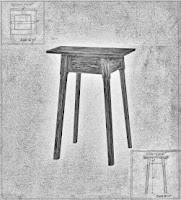One of the key things levied at me in terms of both this blog's utility and the utility of the OSR blogosphere in general is the preponderance of resources - table generators in particular.
So, though I'm not sure I understand: I'm here to help and like to contribute. Presented as follows, a procedural table generation mechanism. Delve on, readers!
1. Roll 1D20 for Type
The type of table informs its purpose and features.
| 1d20 | Result | 1d20 | Result |
|---|---|---|---|
| 1 | Accent |
11 | Drum |
| 2 |
Altar | 12 | End |
| 3 |
Billiards | 13 | Foyer |
| 4 |
Butterfly | 14 | Hutch |
| 5 | Card | 15 | Kitchen |
| 6 |
Coffee | 16 | Nightstand |
| 7 |
Conference | 17 | Ottoman |
| 8 | Console | 18 | Patio (or Picnic) |
| 9 |
Dining | 19 | Pub |
| 10 | Drink (or Swivel) |
20 |
Workbench |
2. Roll 1D4 for Shape
The shape of a table refers to the flat surface on which items can be placed.
| 1d4 | Result |
|---|---|
| 1 | Polygonal |
| 2 |
Rectangular |
| 3 |
Round |
| 4 |
Special |
A "special" shaped table has a surface that is not standard, but instead adapted to the purpose of the table - perhaps it is horseshoe shaped, to allow a presenter in the center; perhaps it is zig-zag shaped, allowing multiple seats to face opposing directions, but not each other. Referee discretion.
3. Roll 1D6 for Style
The style of the table refers to the finish and decorative elements of the table.
| 1d6 | Result |
|---|---|
| 1 |
Chic |
| 2 |
Demilune |
| 3 |
Industrial |
| 4 |
Modern |
| 5 |
Nordic |
| 6 |
Trestle |
4. Roll 1D3/10 for Material
The material is the primary material from which the table is made. At the referee's option, a second roll can be made to determine an accent material.
| 1d3 | ||||
| 1 | 2 | 3 | ||
|---|---|---|---|---|
| 1d10 | 1 | Ash (wood) |
Juniper (wood) | Porcelain |
| 2 | Beech (wood) | Laminate | Quartzite (stone) |
|
| 3 | Birch (wood) | Larch (wood) | Rosewood (wood) | |
| 4 | Brass (metal) |
Limestone (stone) |
Silver (or Gold) |
|
| 5 | Cedar (wood) | Mahogany (wood) | Slate (stone) |
|
| 6 | Cherry (wood) | Maple (wood) | Soapstone (stone) |
|
| 7 | Fir (wood) | Marble (stone) |
Spruce (wood) | |
| 8 | Glass | Oak (wood) | Teak (wood) | |
| 9 | Granite (stone) |
Onyx (stone |
Walnut (wood) | |
| 10 | Iron (metal) |
Pine (wood) | Yew (wood) | |
5. Roll 2xD4 for Seating
Roll 1D4 and multiply the result by 2. The resulting number is the number of people who can use the table at once. A table which logically should not have seating around it instead can be assumed to be standing-room.
To account for larger tables, the die should explode - that is, if a 4 is rolled, roll again and sum the result, until such time as the result of the die fall is not a natural 4.
Public domain artwork retrieved from the National Gallery of Art or OldBookIllustrations.com and adapted for thematic use. Attribution in alt text.
April Fool's. ;-)








No comments:
Post a Comment